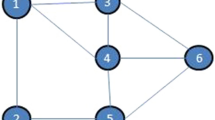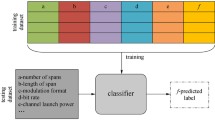Abstract
Nowadays, digital businesses with diverse deployment models such as cloud, mobile and edge devices for the internet of things will impact traffic, in both volume and dynamicity, at unprecedented rates. Moreover, due to the recent advances in optical networks and systems, the complexity of provisioning lightpaths is growing dramatically. Hence, optical network operators are forced to change their insight and move toward intent-based and self-driven networking, to cost-efficiently accommodate these challenging requirements. In this regard, knowledge-defined networking (KDN) promises to play a paramount role in realizing flexible and self-driven optical networks. In this work, we focus on one of the key aspects in this environment, i.e., prediction of quality of service for unestablished lightpaths. KDN is a solution that introduces machine learning techniques into the control plane of the network, to cope with inevitable complexities that arise in enabling network to operate autonomously and faster. For this, five machine learning models are evaluated for the classification and regression approaches. Multilayer perceptron, radial basis function and generalized regression neural network (GRNN) models are used for both of the regression and classification approaches, while support-vector machine and probabilistic neural network (PNN) models are used only for the classification scenario. Also, to discard the redundant features (among the considered experimental features) in the classification approach, input features are selected using the analysis of variance (ANOVA) test. The proposed models can accelerate and handle a significant part of operations in the closed-loop architecture of knowledge-defined optical networks, as a paradigm for designing self-driven optical networks. The best accuracies of quality of transmission prediction (classification approach) and optical signal-to-noise ratio estimation (regression approach) are achieved using PNN (with average accuracy of 99.6 ± 0.5%) and GRNN (with R-squared value of 0.957), respectively.








Similar content being viewed by others
References
Mestres A, Rodriguez-Natal A, Carner J, Barlet-Ros P, Alarcón E, Solé M, Muntés-Mulero V, Meyer D, Barkai S, Hibbett MJ, Estrada G, Máruf K, Coras F, Ermagan V, Latapie H, Cassar C, Evans J, Maino F, Walrand J, Cabellos A (2017) Knowledge-defined networking. ACM SIGCOMM Comput Commun Rev 47(3):2–10
Clark D, Partridge C, Ramming C, Wroclawski J (2003) A knowledge plane for the Internet. In: Conference on applications, technologies, architectures, and protocols for computer communications (SIGCOMM)
Musumeci F, Rottondi C, Nag A, Macaluso I, Zibar D, Ruffini M, Tornatore M (2018) An overview on application of machine learning techniques in optical networks. IEEE Commun Surv Tutor. https://doi.org/10.1109/comst.2018.2880039
Mecozzi A, Essiambre R (2012) Nonlinear Shannon limit in pseudolinear coherent systems. J Lightwave Technol 30(12):2011–2024. https://doi.org/10.1109/jlt.2012.2190582
Poggiolini P (2012) The GN model of non-linear propagation in uncompensated coherent optical systems. J Lightwave Technol 30(24):3857–3879. https://doi.org/10.1109/jlt.2012.2217729
Rabbani H, Beygi L, Ghoshooni S, Rabbani H, Agrell E (2018) Quality of transmission aware optical networking using enhanced Gaussian noise model. J Lightwave Technol. https://doi.org/10.1109/jlt.2018.2881607
Shao J, Liang X, Kumar S (2014) Comparison of split-step fourier schemes for simulating fiber optic communication systems. IEEE Photon J 6(4):1–15. https://doi.org/10.1109/jphot.2014.2340993
Sartzetakis I, Christodoulopoulos K, Tsekrekos C, Syvridis D, Varvarigos E (2016) Quality of transmission estimation in WDM and elastic optical networks accounting for space-spectrum dependencies. J Opt Commun Netw 8(9):676. https://doi.org/10.1364/jocn.8.000676
Carena A, Bosco G, Curri V, Jiang Y, Poggiolini P, Forghieri F (2014) EGN model of non-linear fiber propagation. Opt Express 22(13):16335. https://doi.org/10.1364/oe.22.016335
Soumplis P, Christodoulopoulos K, Quagliotti M, Pagano A, Varvarigos E (2017) Network planning with actual margins. J Lightwave Technol 35(23):5105–5120. https://doi.org/10.1109/jlt.2017.2743461
Pointurier Y (2016) Design of low-margin optical networks. J Opt Commun Netw 9(1):A9. https://doi.org/10.1364/jocn.9.0000a9
Vejdannik M, Sadr A, de Albuquerque VHC, Tavares JMRS (2018) Signal processing for NDE. In Ida N, Meyendorf N (eds) Handbook of advanced non-destructive evaluation. Springer, Cham. https://doi.org/10.1007/978-3-319-30050-4_53-1
Vejdannik M, Sadr A (2015) Application of linear discriminant analysis to ultrasound signals for automatic microstructural characterization and classification. J Signal Process Syst 83(3):411–421. https://doi.org/10.1007/s11265-015-1029-x
Vejdannik M, Sadr A (2016) Automatic microstructural characterization and classification using dual tree complex wavelet-based features and Bees Algorithm. Neural Comput Appl 28(7):1877–1889. https://doi.org/10.1007/s00521-016-2188-9
Vejdannik M, Sadr A (2016) Automatic microstructural characterization and classification using higher-order spectra on ultrasound signals. Journal of Nondestructive Evaluation. https://doi.org/10.1007/s10921-015-0332-6
Vejdannik M, Sadr A (2016) Automatic microstructural characterization and classification using probabilistic neural network on ultrasound signals. J Intell Manuf 29(8):1923–1940. https://doi.org/10.1007/s10845-016-1225-y
Sartzetakis I, Christodoulopoulos K, Varvarigos E (2019) Accurate quality of transmission estimation with machine learning. J Opt Commun Netw 11(3):140. https://doi.org/10.1364/jocn.11.000140
Christodoulopoulos K, Sartzetakis I, Soumplis P, Varvarigos E (2020) Machine learning assisted quality of transmission estimation and planning with reduced margins. Opt Netw Des Model 1:211–222. https://doi.org/10.1007/978-3-030-38085-4_19
Panayiotou T, Savva G, Tomkos I, Ellinas G (2019) Centralized and distributed machine learning-based QoT estimation for sliceable optical networks. arXiv:1908.08338 [cs.NI]
Rottondi C, Barletta L, Giusti A, Tornatore M (2018) Machine-learning method for quality of transmission prediction of unestablished lightpaths. J Opt Commun Netw 10(2):A286–A297
Aladin S, Tremblay C (2018) Cognitive tool for estimating the QoT of new lightpaths. In: Optical fiber communication conference (OFC), paper M3A.3
Morais R, Pedro J (2018) Machine learning models for estimating quality of transmission in DWDM networks. J Opt Commun Netw 10(10):D84. https://doi.org/10.1364/jocn.10.000d84
Caballero F, Ives D, Zhuge Q, O’Sullivan M, Savory SJ (2018) Joint estimation of linear and non-linear signal-to-noise ratio based on neural networks. In: Optical fiber communication conference (OFC), paper M2F.4
Caballero F et al (2018) Machine learning based linear and nonlinear noise estimation. J Opt Commun Netw 10(10):D42. https://doi.org/10.1364/jocn.10.000d42
Mo W, Gutterman C, Li Y, Zhu S, Zussman G, Kilper D (2018) Deep-neural-network-based wavelength selection and switching in ROADM systems. J Opt Commun Netw 10(10):D1. https://doi.org/10.1364/jocn.10.0000d1
Wolpert D (1996) The lack of a priori distinctions between learning algorithms. Neural Comput 8(7):1341–1390. https://doi.org/10.1162/neco.1996.8.7.1341
Simon H (2008) Neural networks. Prentice-Hall of India, New Delhi
Cox D, Donnelly C (2011) Principles of applied statistics. Cambridge University Press, Cambridge
Ancona F, Colla A, Rovetta S, Zunino R (1997) Implementing probabilistic neural networks. Neural Comput Appl 5(3):152–159. https://doi.org/10.1007/bf01413860
Mestres A et al (2017) Knowledge-defined networking. ACM SIGCOMM Comput Commun Rev 47(3):2–10. https://doi.org/10.1145/3138808.3138810
Author information
Authors and Affiliations
Corresponding author
Ethics declarations
Conflict of interest
The authors report no conflicts of interest. The authors alone are responsible for the content and writing of this article.
Additional information
Publisher's Note
Springer Nature remains neutral with regard to jurisdictional claims in published maps and institutional affiliations.
Rights and permissions
About this article
Cite this article
Vejdannik, M., Sadr, A. Machine learning-based QOT prediction for self-driven optical networks. Neural Comput & Applic 33, 2919–2928 (2021). https://doi.org/10.1007/s00521-020-05123-y
Received:
Accepted:
Published:
Issue Date:
DOI: https://doi.org/10.1007/s00521-020-05123-y




